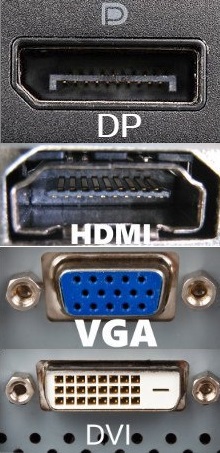Are you staring at a blank screen? Don’t worry, you’re not alone. Millions of people experience no signal issues with their monitors every year. But don’t despair! There are a few simple steps you can take to fix the problem.
Seeing a “No Signal” message on your monitor is frustrating. It happens when the monitor can’t get any input from your computer or device, leaving the screen blank and causing a lot of stress.
The “No Signal” error can be caused by loose or faulty cables, outdated graphics drivers, wrong resolution settings, or hardware conflicts. Sometimes, a malfunctioning graphics card or a faulty monitor can be a problem, and even power surges can disrupt the signal.
In this article, we’ll walk you through the most common causes of no-signal issues and how to fix them. We’ll also provide some tips to help you prevent these problems from happening in the future. So, let’s take a look.
Why Is My Monitor Saying No Signal?
The no signal error appears on Windows 10/11 when your monitor is on but isn’t detecting a signal from the connected device.
Several things can cause this issue, some more severe (and costly) than others. These include:
- Loose cable connections.
- Incorrect monitor input source.
- Faulty or damaged cable.
- The monitor is not powered on.
- PC or device not powered on.
- The PC needs a restart.
- The issue with the graphics card.
- Monitor settings not matching graphics settings.
- Outdated graphics drivers.
- Incompatible monitor or graphics resolution.
- Faulty monitor.
- Hardware or software conflicts.
How to Fix No Signal on Computer Monitor
If the computer turns on but shows no display on the computer, then try the below potential fixes;
1. Turn Off the Computer
First, unplug the cable that connects your monitor to your PC, and then plug it back in securely. This simple step can often fix the issue, as a loose cable is the most common cause of the problem.
If the monitor still doesn’t display a signal after firmly reattaching the cable, check the cable itself for any visible damage. If you notice any damage, the cable may be the culprit behind the problem and might need replacement.
2. Check the Cables
This is the most common cause of the “No Signal” issue. Make sure that the cables are properly connected to both the monitor and the computer. You can also try using different cables to see if that fixes the problem.
Here’s how to properly check your DVI, HDMI, or DisplayPort cables:
- Unplug each cable and then replug them. Ensure each one is properly connected (fully pushed in).
- It sounds obvious, but you should also make sure each cable is in the right place.
- Next, inspect for cable damage. Look for fraying, bends, and nicks. Since some issues can’t be seen easily, it’s also a good idea to rub your finger along each cable. This will allow you to feel for less obvious issues.
- Examine the cable ports. Dust and debris can clog up the ports and interfere with the connection.
- Now, test each cable on a different monitor. If you don’t own a spare monitor, we recommend asking a friend if you can use theirs.
- If a cable doesn’t work with the new monitor, it’s likely the root cause behind the no signal issue. You will need to buy a new cable.
3. Select the Correct Input Source
Make sure that the monitor is set to the correct input source. This is usually done by pressing a button on the monitor’s front panel.

Follow the instructions below to select the correct input source for your monitor:
Step 1: Ensure your PC and your monitor are both turned on.
Step 2: Press the menu button on the edge of your monitor.
Step 3: Navigate to Input Source and select the correct input source. For example, if you connect your monitor to the VGA port on your PC, then set the input source as VGA.
4. Reset the Monitor
This can sometimes fix minor issues with the monitor. To do this, simply unplug the monitor from the power outlet for a few seconds, then plug it back in.
5. Reset the CMOS
When your monitor says no signal when HDMI is plugged in, then resetting the CMOS can fix your problem;
What is a CMOS?
CMOS stands for Complementary metal–oxide–semiconductor. It’s basically a small battery that sits on your motherboard.
To reset the CMOS you need to do the following:
Step 1: Shut down your PC and then unplug all the cables.
Step 2: Open up the case and have a look around for the CMOS battery.
Step 3: Carefully remove it from the motherboard.
Step 4: Leave it for 3 minutes and then put the CMOS back where you removed it from.
5. Reset the Computer
This can also fix some problems with the computer. To do this, press and hold the power button for about 10 seconds until the computer turns off. Then, turn it back on and see if the problem is fixed.
6. Ensure the Graphics Card is Securely Inserted
If your monitor says no signal and then goes to sleep, then check if your graphics card is not firmly inserted in its slot. In this case, you need to open your computer case to check. Here is how to do it:
Step 1: Turn off your computer, then disconnect all the cables (including your power cord) and the attached devices from your computer.
Step 2: Open your computer case to locate your graphics card.
The exact location of the graphics card depends on the type of card on your computer. If you’re not sure, please consult your PC manufacturer for assistance.
Step 3: Remove your graphics card from your motherboard and then insert it firmly in its slot.
Step 4: Plug the power cable of your monitor back in and connect it to your PC.
Step 5: Hold the power button down for 30 seconds to a minute and then connect your power cord back and turn it on.
If you replaced your video card but still don’t get a signal, consider replacing the computer’s power supply and, in a worst-case situation, the motherboard.
See if this issue persists. If you still get the no signal message on your screen, don’t worry! There are more fixes for your to try.
7. Check the Adapters
Check the adapter if you are using one. A faulty display adapter or an incompatible adapter type can hinder the connection and lead to the “no signal” issue. Make sure the adapter supports multiple monitors and the monitor’s configured resolution to avoid problems.
8. Test the Monitor With Another Computer
If you have another computer, you can try connecting the monitor to it to see if it works. This will help you to determine if the problem is with the monitor or the computer.
9. Take the Monitor to a Repair Shop
If you have tried all of the above steps and the problem is still not fixed, you may need to take the monitor to a repair shop.
If your computer is under warranty, it’s best to arrange an official repair before opening it up yourself. Opening it on your own might void the warranty.







